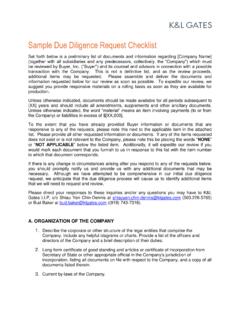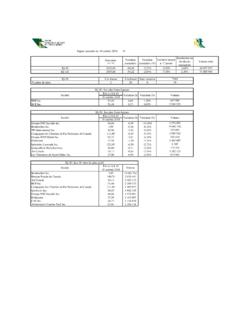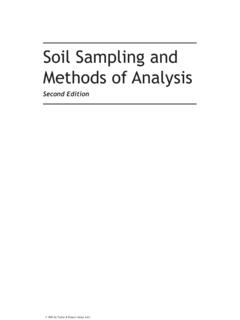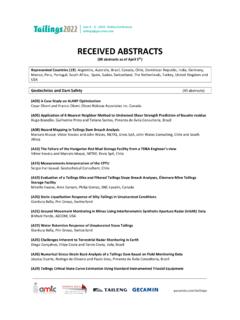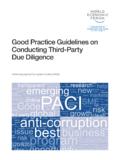Transcription of 2019 Offshore Wind Handbook - K&L Gates
1 Offshore wind Handbook Version 2 | October 2019. Beatrice- Offshore - wind -farm Courtesy of Scottish Construction Now Table of Contents Introduction 5. Offshore wind Overview 7. Introduction 7. Market Drivers 8. Global Market Overview 8. Market Overview 10. Laws and Regulations Shaping Offshore wind Development 13. Federal Offshore Policy and Regulatory Issues 13. State Offshore Policy and Regulatory Issues 19. Massachusetts 19. Maine 21. Maryland 21. New Jersey 22. Rhode Island 22. Connecticut 23. New York 24. Virginia 25. California 26. Hawaii 26. The Jones Act Maritime Law 28. Offshore wind Legal Framework 33. Equipment Supply/EPC and Long-Term Service Agreements 33. Interconnection Issues FERC and ISO 37. Power Purchase Agreements 40. Renewable Energy Tax Credits 46. Project Phasing 49. Project Planning 49. 2 Offshore wind Handbook October 2019.
2 Consent and Permitting 53. Project Permitting 53. Planning and Analysis 53. Leasing 53. Site Assessment 54. Construction and Operations Plan 55. Other Pre-Construction Permits and Coordination 56. Post-Construction Mitigation and Monitoring 56. The Offshore wind Infrastructure 59. Offshore wind Turbines (WTG) 59. WTG Foundations and Substructures 60. Offshore Electrical Systems and Subsea Cables 62. Development Challenges and Project Risk 67. Construction and Offshore Installation 71. The Marine Environment 71. Manufacturing 71. Offshore Installation 72. Commissioning 77. Asset Management and Decommissioning 79. Pre-operation 80. Operation and Maintenance 80. Life Extension 82. Decommissioning 82. Appendix A: Contributors 83. Appendix B: Company Background 84. K&L Gates 84. SNC-Lavalin/Atkins 85. Table of Contents 3. Dudgeon Offshore wind Farm Courtesy of Smulders 4 Offshore wind Handbook October 2019.
3 Introduction The much-anticipated dawn of the Offshore wind energy industry in the is now upon us and making significant development headway particularly on the Eastern seaboard. Through the hard-earned progress of industry and governmental leaders in the and abroad, we now see a project development landscape of favorable policy and regulatory programs, advantageous pricing for proven reliable technology and construction services, and a pool of specialized expertise necessary for successful project development. All of these factors lead to the aggressive pricing we are now seeing in the power markets, with a likelihood of further cost compression to come. The time is now and the opportunity is before us. First harnessed more than twenty years ago, the Offshore wind industry is set for dramatic global growth. As the industry matures in Europe and developers in Asia and North America move to follow Europe's example, legal and regulatory frameworks are evolving quickly to accelerate project deployment and integrate these resources into the legacy power market.
4 According to the Global wind Energy Council's Global wind 2018 Report, the global Offshore market remained stable in 2018 with GW of new additions, the same market size as in 2017. The total cumulative installations has now reached 23 GW. Advances in technology and efficiencies in installation have contributed to huge reductions in the cost of Offshore wind power and this is expected to continue. In addition to the obvious green credentials, Offshore wind power is now economically competitive. No surprise then that interest in the sector is booming. This Handbook is the result of collaboration between SNC-Lavalin's Atkins business, an international leader in the Offshore wind design and construction industry and K&L Gates , a leading international law firm. The intent of this Handbook is to review the current progress in the Offshore wind market and to outline some of the challenges faced by this dynamic and expanding market.
5 David P. Hattery na Brosnan Practice Group Coordinator Power Group, Seattle, USA Business & Strategy Development Manager, Glasgow, UK. The Offshore wind Handbook is a joint publication of K&L Gates , LLP and SNC-Lavalin's Atkins business for the benefit and information of any interested parties. This document is not legal advice or a legal opinion on specific facts or circumstances. The contents are intended for informational purposes only. Table of Contents Introduction 5. Block Island Offshore wind Farm Courtesy of Deepwater wind 6 Offshore wind Handbook October 2019. Offshore wind Overview AUTHOR: na Brosnan, Atkins Introduction > Lower levels of Offshore wind turbulence resulting in higher capacity factors (typically 40% higher than The Offshore wind industry was launched in 1991 with onshore wind ). the construction of the first Offshore windfarm (Vindeby).
6 Off the coast of Denmark with eleven 450 kW turbines. > Opposition to Offshore wind farms tends to be lower The industry has continued to build on this technology due to its Offshore location and distance from which has naturally led to Europe now being the leader populated areas and reduced visual impact. in Offshore wind power. > Use of larger turbines in Offshore location the size of the turbines is significantly higher with Offshore Offshore wind energy is the use of wind farms turbines currently ranging from - 12GW. constructed in the ocean (traditionally on a shallow continental shelf) to harvest wind energy to generate > In the early days of Offshore wind development, the electricity. The development of the shallower cost was high (typically US$215/MWh) however in (typically up to 60m water depths) coastal areas recent years Offshore wind costs have tumbled utilizing transitional fixed bottom substructures has (~US$ ).
7 The industry's success in reducing been dominant to date and has experienced significant the overall cost can be attributed to the following: cost reduction in the last three years. Deep water areas are now also being explored that would utilize > Strong, stable political drivers and floating wind turbines. This floating technology is support mechanisms becoming more feasible as technical readiness levels > Larger turbines improve and larger scale developments are deployed. > Collaboration Expect to see significant cost reductions with this > Innovation technology in the coming years as developments continue to progress from demonstration > Standardizing developments to full scale commercialization. > Repeatability > Industrialization There are many benefits of locating the wind turbines > Market competition Offshore namely: > A better understanding of risk > Abundance of space Offshore .
8 > Cheaper financing > Higher and less turbulent wind resources Offshore compared to on land therefore higher generation per amount of capacity installed. Table of Contents Offshore wind Overview 7. Market Drivers Global Market Overview The demand for global electricity is growing and The Offshore wind market is truly becoming a global projected to continue this trajectory with the transition Offshore market with capability now growing in Asia and to low carbon forms of energy. The energy trilemma is a the US where we see markets to become firmed term which is frequently used at political levels to embedded at these locations in the next five years. The describe the balance requirement between energy first of the large-scale commercial Offshore wind farms security, social impact and environmental sensitivity. in the US are expected to commence Offshore The fundamental drivers for Offshore wind globally are installations in 2022/2023.
9 Orientated around energy security, de-carbonization and industrial/job-creation and are likely to persist in At present, global Offshore wind farms installed capacity importance in the future. The significant cost reductions sits at over 23GW with the UK currently leading the way experienced in recent years are now driving Offshore with the world's largest Offshore wind market with an wind development globally post 2020 toward 2030 with installed capacity of over (June 2019) which international governments and customers placing a accounts for just over 36% of the global installed larger emphasis on nations for greener, more secure capacity. 2017 and 2019 have proved to be milestone and cheaper forms of energy. Offshore wind has now years to date: become a strong contender in their overall energy mix. > In 2017, over GW of new Offshore wind power was installed in nine markets globally which represented CARBON EMISSIONS.
10 An increase of 95% on the 2016. In 2017, the world's first zero subsidy bids for Offshore wind were awarded in Germany and the Netherlands where turbine sizes of 12MW to 15MW were first outlined to deliver the above mentioned zero bid/zero subsidy projects. THE ENERGY. > In 2018, China installed and connected more Offshore TRILEMMA wind capacity ( ) than any other country globally (including the market leader the UK);. SECURITY. OF ENERGY. SUPPLY. > In 2019, Offshore wind strike prices were seen to fall by almost a third (From 2017 UK lowest strike price of ENERGY COSTS ) in the UK's latest contracts for difference (CfD) tender. A strike price of was secured on projects due online in 2023/24. Overall this is 31% lower than the lowest bid in the 2018 CfD auction and a 50% reduction from the UK's first tender. Offshore wind resource In the initial days, Offshore wind was expensive compared development would help the to conventional forms of generation and required heavy ACHIEVE 20% OF subsidy support to drive the industry maturity.
